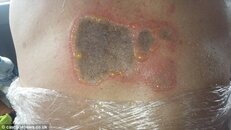- Messages
- 54,470
- Reaction score
- 8,575
- # of dives
- 500 - 999
Diver suffered chemical burns in freak accident 160ft below sea level | Daily Mail Online

A diver who suffered a chemical burn in a freak accident 160ft below sea level claims he survived only because of his calm reaction.
Gavin Anderson, 50, was wearing a therapeutic heat pad for back pain during a deep dive in the Forth when the pack exploded after reacting with gas in his tank.
The explosion badly burnt part of Mr Anderson's back, causing intense pain while he was 160ft below the water's surface.
But aware that if he ascended in a panic he could suffer potentially fatal decompression sickness, Mr Anderson enduring an agonising 20minute ascent following correct procedures.
The disaster unfolded on Saturday when he was using gas enriched with oxygen instead of the oxygen tank he normally uses. But when he vented his dry suit, the gas reacted with the chemical in the heat pack pack.
Dry suits - which differ from wet suits in that they are designed to prevent water entering them - require venting in order to control their buoyancy.
Mr Anderson, a photographer from Milnathort, Kinross-shire, said: 'This was a pretty unusual situation but it could happen to someone else so people should be aware that these heat pads can be quite dangerous in certain circumstances.'
He had sailed with fellow divers to a submarine wreck in an area known as Wee Bankie, 16miles east of Anstruther, when the incident occurred around midday on Saturday.
He said: 'I was at 50 metres (164ft) when it started to burn and I had to come up slowly. The problem was it continued to burn as I was coming up.
'The pain was isolated to a small area of my back so I could just about cope with it, but it was a pretty horrible experience.'
He was given first aid by crew on the Mako dive boat, including skipper Steve Haddow who he thanked for raising the alarm, and Anstruther lifeboat, before being rushed by ambulance to Ninewells Hospital in Dundee.
The all-weather lifeboat was dispatched at 12.20pm and the inshore lifeboat brought paramedic shore crew member Morag Morris to assist.
Mr Anderson was released from hospital on Saturday evening but his burn is so severe that he is to return for a skin graft tomorrow.
The response of the dive boat skipper and fellow divers was commended by Anstruther lifeboat operations manager John Murray.
Mr Murray said: 'I have to praise the skipper of the local dive boat and the divers themselves for the way in which they remained calm. They were well equipped and ready to deal effectively with this incident.
'Morag was on scene to assist and this man was handed over to the ambulance crew having received the very best level of first aid'.




